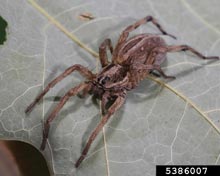
Joseph Berger

Whitney Crenshaw, Colorado State University
Wolf Spiders
General Description
Any large, hairy spider in the eastern half of the United States is more than likely a wolf spider. These spiders
may grow to have bodies one inch long with a leg span of 2 or more inches. They are generally black or gray in
color, but sometimes reddish-brown or tan. Two of their eight eyes are often larger than the rest.
Wolf spiders are active hunters that search for prey day or night. Some burrow and others rest in silken retreats beneath rocks, logs and vegetation. Females attach their egg sacs to their spinnerets and carry the spiderlings around after they hatch. As with other large spiders, the bite of a wolf spider is likely to be felt but is not considered dangerous. Bites from these and other large spiders are uncommon.
General Control
Inspect the facility on a routine basis and seal all cracks, repair screens and ensure door sweeps are installed
properly to prevent the spider from entering the facility. Monitoring traps can be used to catch the spiders. If wolf
spiders are frequently found indoors, pesticides can be applied to areas such as crawlspaces and basements.
Microencapsulate formulations work well against these and other spiders.









